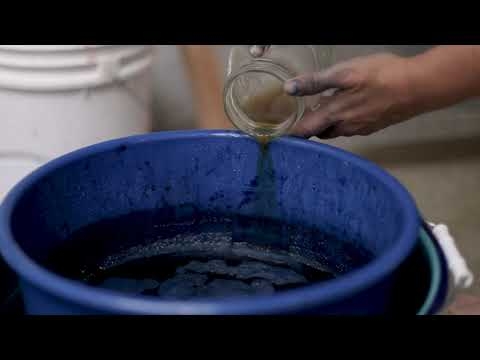Abigail Rothberg ’01, Mary Elvira Stevens Fellow (2019-2020)

At some point in 2018, I realized I had to stop thinking of my professional life and what brought me joy as two distinct parts of my life. I needed what I did professionally to reflect who I am: a person passionate about social justice, and also someone who is silly and loves to laugh, someone imperfect and impatient, someone who loves staring at art, and someone who literally loves getting her hands dirty. (I currently have the indigo-stained hands to prove it.) This shift in values is what ultimately led me to apply to the Mary Elvira Stevens Fellowship for a second time, this time led by the desire to blend my once distinct professional and playful selves. For my second application, I thought of the Stevens Fellowship not merely as a way to develop my career, but as a way to foster personal growth so I could learn to experience joy in my work and ultimately share that joy with others.
In the previous year, I had applied for the Stevens Fellowship with a project based strictly on where I was professionally—working in the women’s rights field measuring project impact for donors. That year, the committee decided they couldn’t fund my proposed project because the application didn’t quite resonate with the “deep love of beauty” Alice Alvira Stevens stipulated was essential to receiving the Fellowship.* The committee chair offered feedback on my application and encouraged me to apply again, just as she had done before receiving the Stevens. I hesitated because I wasn’t sure how to frame my project any differently. That application felt, at the time, like an accurate presentation of my professional goals.
My new project focused on exploring traditional weaving by indigenous women in Guatemala and Mexico. I had become interested in textiles during consulting work I had done in Guatemala in previous years. The beauty of the handwoven textiles was mesmerizing, and I wanted to learn more about the tradition and practices of weaving in the region. This second application came together nicely, weaving together (if you will) my past professional experience with a new passion that touched on both my professional desires and well as on my interest in a craft I found beautiful. I was selected for an interview by the committee and the interview was an affirming experience. Each committee member understood my essays, my intentions, and my strong desire to connect my profession with joy. Their connection to my project gave me the confidence to seek the balance that Alice Alvira Stevens outlines in her brief description of the ideal candidate, someone who is (under my interpretation) both logical and empathetic in their approach to the unfamiliar, and whose pursuits are a blend of professionalism and passion.
I surely wouldn’t be sitting where I am right now without having gone through the process of applying for this Fellowship twice. Nor would I have had the courage to follow my own desires without the support of the Fellowship committee. Of course the Fellowship experience went differently than I imagined and the project veered from what I had originally planned. Completely unexpectedly, I fell in love with indigo dye. This natural dye has become a new passion of mine (thus the aforementioned, indigo-stained hands). Upon learning the complex process of producing indigo that has existed for thousands of years, I wanted to learn everything I could about the dye’s history, how people work with it all over the world, and how I could work with it. This led me to spend more time in Guatemala than I originally planned. And then, I stayed even longer.
I am typing this from my studio in Antigua, Guatemala, where I practice natural dye methods with indigo daily. I feel so much joy when my hands are plunged inside the dark blue vat, holding cotton fibers, and working in the dye. When people come by to see what I am working on, I light up as I tell them about it. They too can’t help but become excited, or at the very least, curious to know more, and to dip something in the vats themselves.
Thanks to the Stevens Traveling Fellowship, I am learning through play each day. I am learning how joy and levity can play a role in professional interactions, as well as how my professional aims are strengthened when they are more inclusive of my whole self. In these complicated times, I can’t say where indigo will lead me. Some local weaving groups in Guatemala want to reclaim the recently lost art of indigo dyeing, and perhaps there is an opportunity that awaits me to learn and share with local artisans. I am also designing products using indigo-dyed threads and wood which I may sell one day. For me, what exactly transpires is not as important as the continued practice of inserting joy, my whole and true self, into whatever I do.
*Alice Alvira Stevens set up the trust for the Stevens Fellowship in her sister’s name and wrote the brief outlining the ideal candidate for the Fellowship.
[Video by: @estudiocuatrosantos in Antigua, Guatemala. To follow along my indigo journey, find me @mysafinecrafts.]



